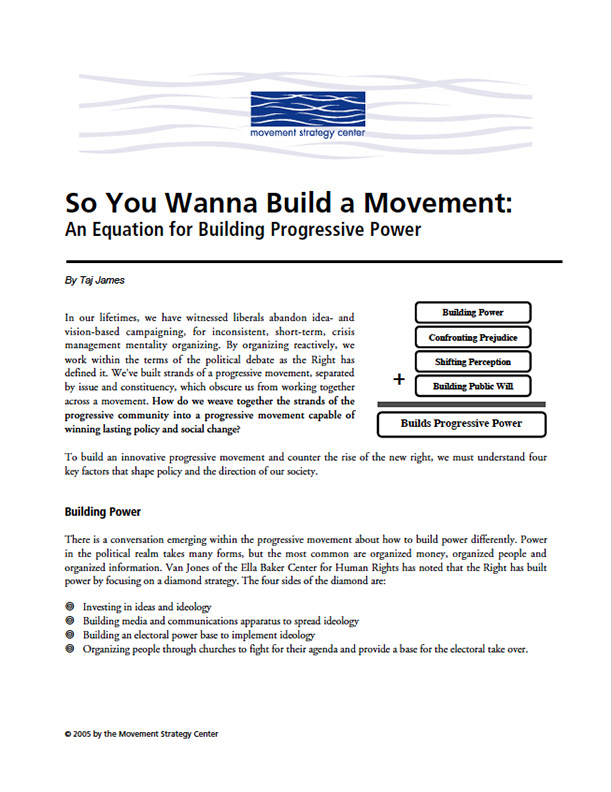So You Wanna Build a Movement: An Equation for Building Progressive Power
This article explores ways to unite different strands of the progressive movement in order to build power and creates long-lasting social change. It examines four key factors that shape policy and society: building power, confronting prejudice, shifting perception, and building public will. Published in Social Policy Magazine, the New Progressive Politics Issue, Spring 2005.
By Taj James
Published 2005
In our lifetimes, we have witnessed liberals abandon idea- and vision-based campaigning, for inconsistent, short-term, crisis management mentality organizing. By organizing reactively, we work within the terms of the political debate as the Right has defined it. We’ve built strands of a progressive movement, separated by issue and constituency, which obscure us from working together across a movement. How do we weave together the strands of the progressive community into a progressive movement capable of winning lasting policy and social change?
To build an innovative progressive movement and counter the rise of the new right, we must understand four key factors that shape policy and the direction of our society.
Building Power
There is a conversation emerging within the progressive movement about how to build power differently. Power in the political realm takes many forms, but the most common are organized money, organized people and organized information. Van Jones of the Ella Baker Center for Human Rights has noted that the Right has built power by focusing on a diamond strategy. The four sides of the diamond are:
– Investing in ideas and ideology
– Building media and communications apparatus to spread ideology
– Building an electoral power base to implement ideology
– Organizing people through churches to fight for their agenda and provide a base for the electoral take over. Building Power
The Right not only built each side of the diamond but each piece was developed in relationship to the other three. Some of the recent attempts by liberals to mimic the Right’s strategy tried to isolate one piece of the diamond. For progressives to win, we need to not only do all four things well, but to do them well in combination. There are no shortcuts.
Prejudice and Structural Racism
A progressive movement must learn how to recognize and address structural racism, which continues to be the biggest social force shaping U.S. public policy. Structural racism has shaped the allocation of resources, education policy, housing policy, welfare policy, and foreign policy. Right wing political and research strategies are developed to deepen, expand and exploit structural racism and prejudice as a way to maintain power and divide oppressed groups. The progressive movement has been unable to consolidate itself because of a continued failure to recognize the centrality of race to the U.S. power structure, and because of the ongoing struggle within the racial justice movement to deal with the ways that patriarchy and class divides communities. An authentic progressive movement with the capacity to capture the hearts and minds of the U.S. people, and capture the institutions of power in the society, must support the vision and leadership of people of color, women and working class people.
Perception
Progressives must learn how to use framing to build progressive power, promote our values, and expose the truth that Right wing propaganda so skillfully obscures. We must confront the reality that the Right’s race-framing of social policy has allowed them hide their real agenda. In private, most policy makers will acknowledge that it doesn’t matter what is “true” in the sense of what a rigorous research process can confirm — it matters more what people perceive to be true. Perception of crime drives crime policy, not the actual rate of crime. This explains how, on a national level, the Right was able to inflate the prison population and pass “get tough on crime” laws that endanger our communities, even while violent crime was dramatically decreasing. The association of criminality with blackness and people of color, as well as the deep historical fears in white America of the black criminal, trump fact and figures in the public’s perception. The Right approaches their work from the standpoint of waging low intensity racial and class warfare — they view and treat information as propaganda to be wielded. Progressives can learn to use the power of positive, engaging frames, in order to elevate both our key values and the facts behind them.
Public Will
For progressive movements to succeed, we must engage and mobilize our traditional base, and we must connect with and communicate to the broader public, which has been so skillfully manipulated by the Right. Polling has a tremendous impact on how decision-makers shape policy. This is in large part because polls are developed to reflect and maintain the current relationships of power. Public opinion, as expressed in polls, is most often not the opinion of the entire population. It is most often the opinion of a particular public: the voting public — which is older, wealthier and whiter than the larger population. Progressives must again learn to wage fights that don’t respond to the majority consensus that the Right has fostered, but to build public will for progressive values and agenda.
One excellent example of this is the Campaign for Quality Education (CQE), a statewide alliance of community, legal, research and policy groups led by Californians for Justice. While pollsters are reporting that California voters are strongly opposed to raising taxes, CQE is leading a campaign that exposes that the state is failing the students of California by denying them the basic resources they need to succeed in school. The campaign reasserts the rights of students to basic support and the state’s responsibility to provide that support. CQE’s campaign is building the foundation of public will that will allow communities to turn back the tax revolt launched in California by Proposition 13, and spread across the nation 20 years ago. There is a deep cultural change underway in the progressive movement, which is radically transforming how we organize and work together. Ask not what your sector of the movement can do for mine — realize that if we do not unite, all of our movements will face continual defeats in the face of a unified and ascendant Right wing. The brave organizations and leaders who are driving this change need support from the broader movements. We are not asking for mere words of support, but rather for concrete acts of solidarity that demonstrate an embodied wisdom of our interdependence.
Taj James is the Executive Director of the Movement Strategy Center in Oakland, California. The Movement Strategy Center provides the tools for organizations to work together authentically for a cohesive progressive movement. MSC uses power mapping; strategy and story sharing; and long-term vision planning to bring unlikely partners together and build strong alliances.
Original publication is available here.


